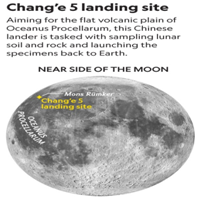

Context
China successfully launched its Chang'e-5 lunar mission to collect rocks from the moon - the first attempt by any country since the 1970s.
About
- The Chang'e-5 probe will attempt to collect 2 kilograms (4.5 pounds) of samples in Oceanus Procellarum.
- Composition: The spacecraft is made up of an orbiter, a lander, an ascender and a returner.
- Time-period: From start to finish, the mission will last more than 20 days.
- Once in the moon's orbit, the probe will deploy a pair of vehicles to the surface to drill into the ground and collect soil and rock samples.
- If successful, the mission will make China only the third country to have retrieved lunar samples, following the United States and the Soviet Union decades ago.
|
Chang’e Program
|
Where will it land?

- The mission will land in the Mons Rumker area of the huge volcanic plain Oceanus Procellarum ("Ocean of Storms"), portions of which have been explored by a number of other surface missions, including NASA’s Apollo 12 in 1969.
- It is a massive lava plain.
- This large dark spot, stretching about 2,900 kilometers (1,800 miles) wide, could be a scar from a giant cosmic impact that created an ancient sea of magma.
The previous attempts
- US astronauts brought back 382 kilograms (842 pounds) of rocks and soil during the Apollo program, between 1969 and 1972.
- The Soviet Union collected 170.1 grams (6 ounces) of samples in 1976.
- In the decades since data from orbital remote sensing missions has shown there is a much greater diversity of rock types and ages on the moon than existing samples suggest.
Significance of the mission
- These samples could help scientists understand more about the moon's origins and foundations and set the foundation for more complex sample retrieval missions in the future, potentially on other planets.
- The mission may help answer questions such as how long the moon remained volcanically active in its interior, and when its magnetic field -- key to protecting any form of life from the sun's radiation - dissipated.


